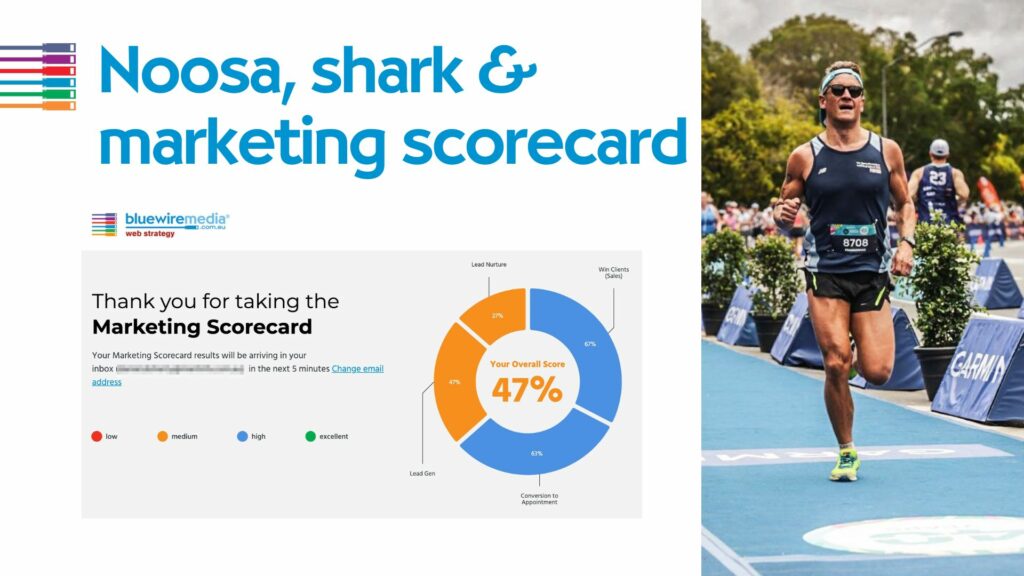Have you ever wondered about how your calls arrive at the correct agent working in a contact center? There’s a lot more than simply directing inbound calls through the phone system.
In this piece, we’ll dive into how call routing systems work, why it’s used, and the various ways to distribute calls to team members.
What Is Call Routing?
Call routing is a phone system feature that connects callers to an intended recipient or department based on predefined criteria. In the case of a call center, live agents are assigned specific queues to handle inbound calls. In most cases, automatic call distribution happens based on what callers provide the interactive voice response system (IVR).
Call routing functionality doesn’t only apply to high-volume scenarios like call centers. Companies of all sizes optimize their incoming business calls so customers can reach the right team or person whenever they call.
Historically, a complex call routing system had to be programmed into a phone system by developers and IT experts.
Now, anyone can use call routing software to visually design inbound call flows to direct them in real-time to team members’ phones or voicemails. No coding is necessary; just drag and drop, as shown below in Nextiva.
An automatic call distributor handles the entire call routing process, from answering phone calls, qualifying them, and then distributing them to a live agent. Some companies also direct calls to an outside answering service to maintain 24/7 coverage.
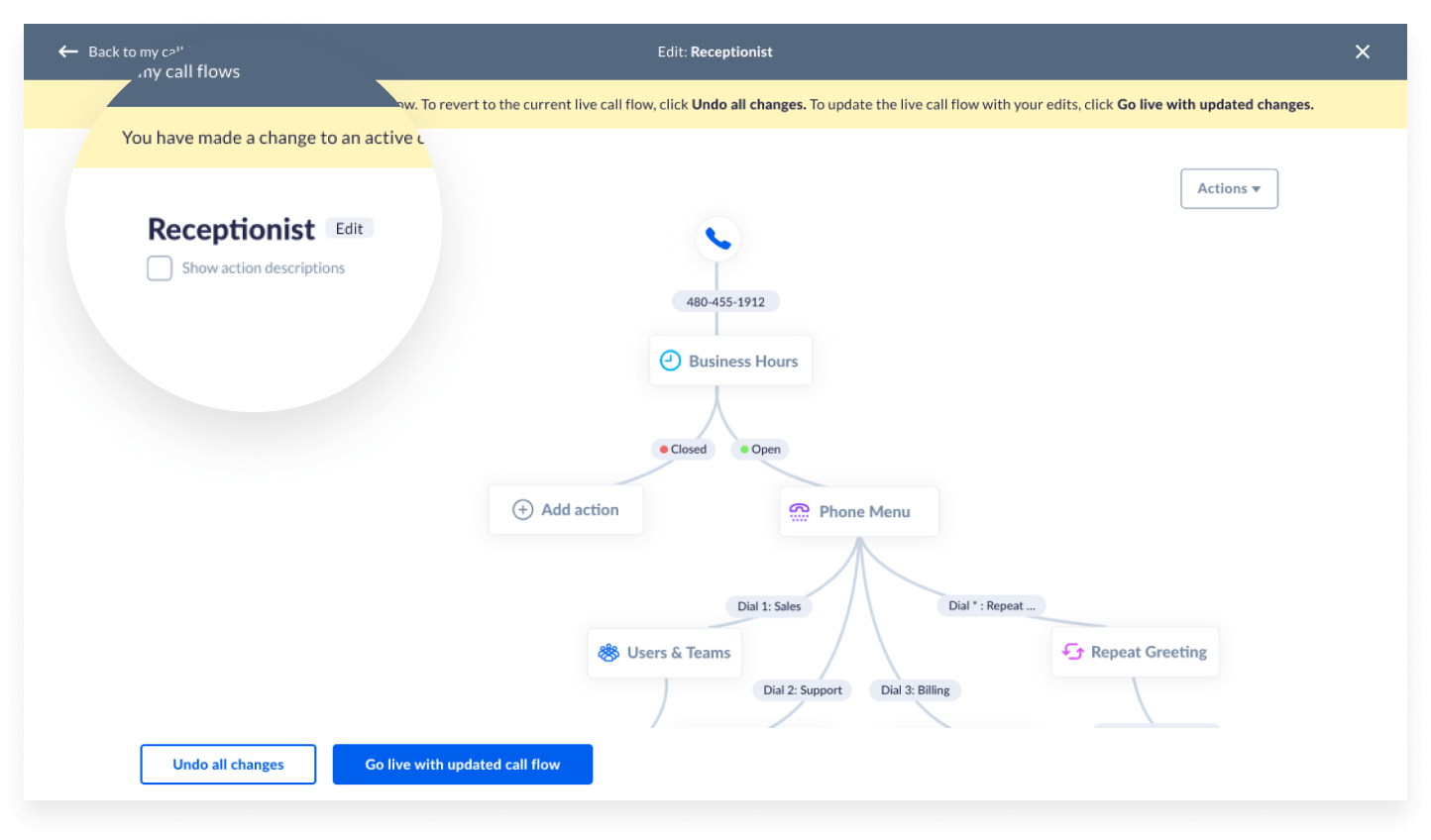
Benefits of Call Routing
There are several reasons to use a call routing service, especially if you handle a high volume of incoming calls.
Benefits for contact centers
- Reduces call waiting times, which improves customer satisfaction and lowers telecom pricing.
- Minimizes inbound calls reaching the incorrect agent or team.
- Improves first-call resolution, which reduces callbacks and churn.
- Optimizes predictive analytics around customer call volume and agent availability.
Benefits for call center agents
- Distributes calls fairly and effectively among team members using set call routing rules.
- Gathers inbound call details using Interactive Voice Response technology.
- Improves customer experience, which leads to faster, more relaxed customer calls
Benefits for customers
- Reaches the best agent to provide customer support based on skill-based routing or other call routing logic.
- Lowers the wait time to reach the desired department due to fewer callbacks and repeat callers
- Provides information faster before entering the call queue, such as business hours, locations, and self-service workflows.
How Does Call Routing Work?
A business phone system routes calls in a variety of ways. When a person calls a small business, the cloud-based phone system accepts the call, provides an auto attendant menu, and transfers the call to the appropriate team member.
Factors used to determine how calls are handled include:
- Time of day: Both the caller and the contact center in different time zones
- Caller ID: The phone number of the incoming call, which also informs about the caller’s location.
- Auto-attendant selections: Input from the caller in response to an auto-attendant menu of choices.
- Agent skill: Direct calls to members of your team better suited based on intelligent call routing logic.
- Customer relationship data: Based on data points stored in your CRM, call center software can use automation to direct incoming calls.
- Interactive Voice Response prompts: If the caller voices their needs, your phone system can use artificial intelligence and machine learning to route the call.
Pro Tip: Call routing isn’t hard to set up. Start with mapping out the common destinations you want to direct inbound calls. When you scale, you can add more sophisticated call routing options.
Different Types of Call Routing
Effective call routing strategies often employ a variety of criteria to direct calls to agents consistently. These call routing rules help small businesses provide a better customer experience.
Here are the most common ways to distribute incoming calls.
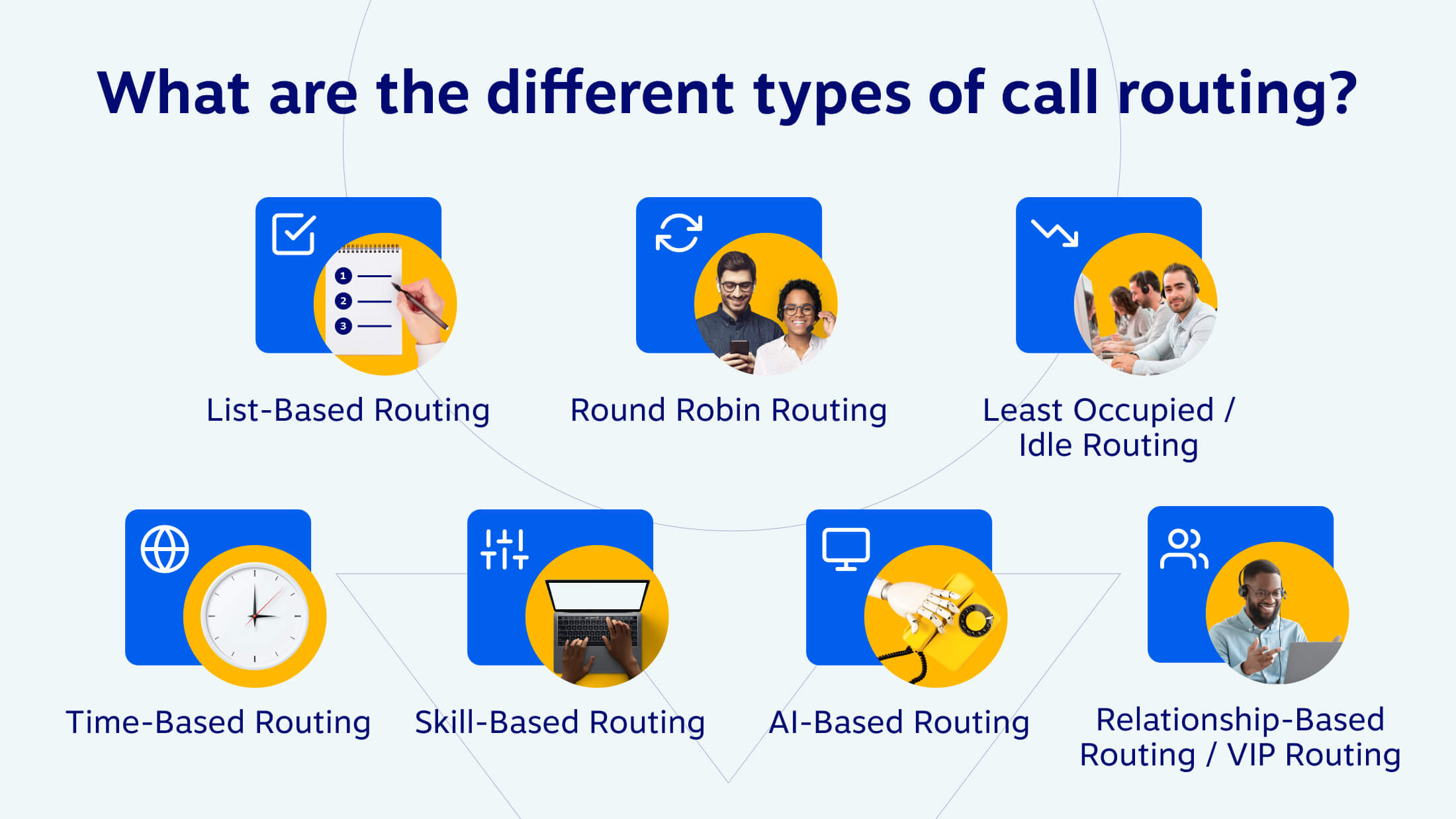
1) List-based routing
While not a commonly used call management feature, list-based routing or sequential routing uses a fixed list or prioritized agents to receive calls.
For example, if the List is A, B, C, D. A will receive a call first, always unless they are busy. If A is busy with a call, B will receive the call. If A and B are both busy, C will be connected. But as soon as A becomes available, he is back on top of the priority list.
This call routing strategy is used when there is a need for expertise or a specific skill level or during training.
2) Round robin routing
Round-robin is the most common call routing system since it evenly distributes calls among agents.
For example, if A, B, C, and D are agents in a queue, and A receives the first call, then the next call to A comes only after B, C, and D attend one call each. This loop keeps on repeating in a uniform and fair manner.
Many call centers use this type of call routing to distribute calls to team members assigned within a given call queue.
3) Least occupied (or most idle) routing
As the name suggests, this routing system routes the calls to call center agents who have either the lowest talk time, received the fewest calls, or the most available time. “Available time” is when an agent is sitting idle, ready for calls but not receiving them.
This is where an intelligent call routing ACD comes into play — it tracks these stats so agents don’t get burned out.
Least occupied routing balances the available time and talk time across the team.
4) Time-based routing
In this system, calls are routed based on the agent’s business hours and time zone. This method is most commonly used at call centers that serve global and geographically diverse customers.
The agents can be working shifts, and calls are routed to those agents who work in those particular shifts only.
As part of a global workforce strategy, you might want to direct calls first to agents located domestically before rolling over calls to an offshore contact center.
5) Skills-based routing
Most commonly used in ACDs, which usually have integration with IVR systems, this kind of routing uses information provided by the customer to connect them to agents with specific skill sets needed to assist the customer.
For example, if you serve banking customers and a client is seeking someone to help reverse a charge that happened due to a system error, the skills-based routing system may find an agent who is authorized and equipped with the right tools to process a refund.
6) AI-assisted routing
Also known as predictive behavior routing, this intelligent call routing technique uses artificial intelligence to recommend the best agent and call path for the caller.
It uses machine learning to predict an agent who will provide the best answer swiftly and in a manner preferred by the customer. The system uses live and historical call center data to determine this in real-time.
This type of call routing system is best for high-volume call centers that have a treasure trove of customer call data.
7) Relationship/VIP routing
This strategy is used in exceptional cases where some numbers or callers are identified for special privileges or are assigned to specific relationship managers.
Suppose you have a short list of VIPs who need to reach an escalations department. You can tag them in your CRM and optimize their call route to bypass all further IVRs or customer support agents.
These calls are routed to those agents assigned to them without delay. In case the agent is not around, the caller is promised and provided a timely callback or assigned to a replacement agent without delay.
So, what’s the best call routing strategy?
One of the best call routing methods is to use a mix of call routing rules together.
For instance, establish the primary purpose of the call with an IVR or auto attendant. Then, apply a combination of VIP routing, skills-based routing, and least occupied across your call queues.
Depending on your cloud phone system, these options can be connected together to provide an efficient and effective to support your business needs.
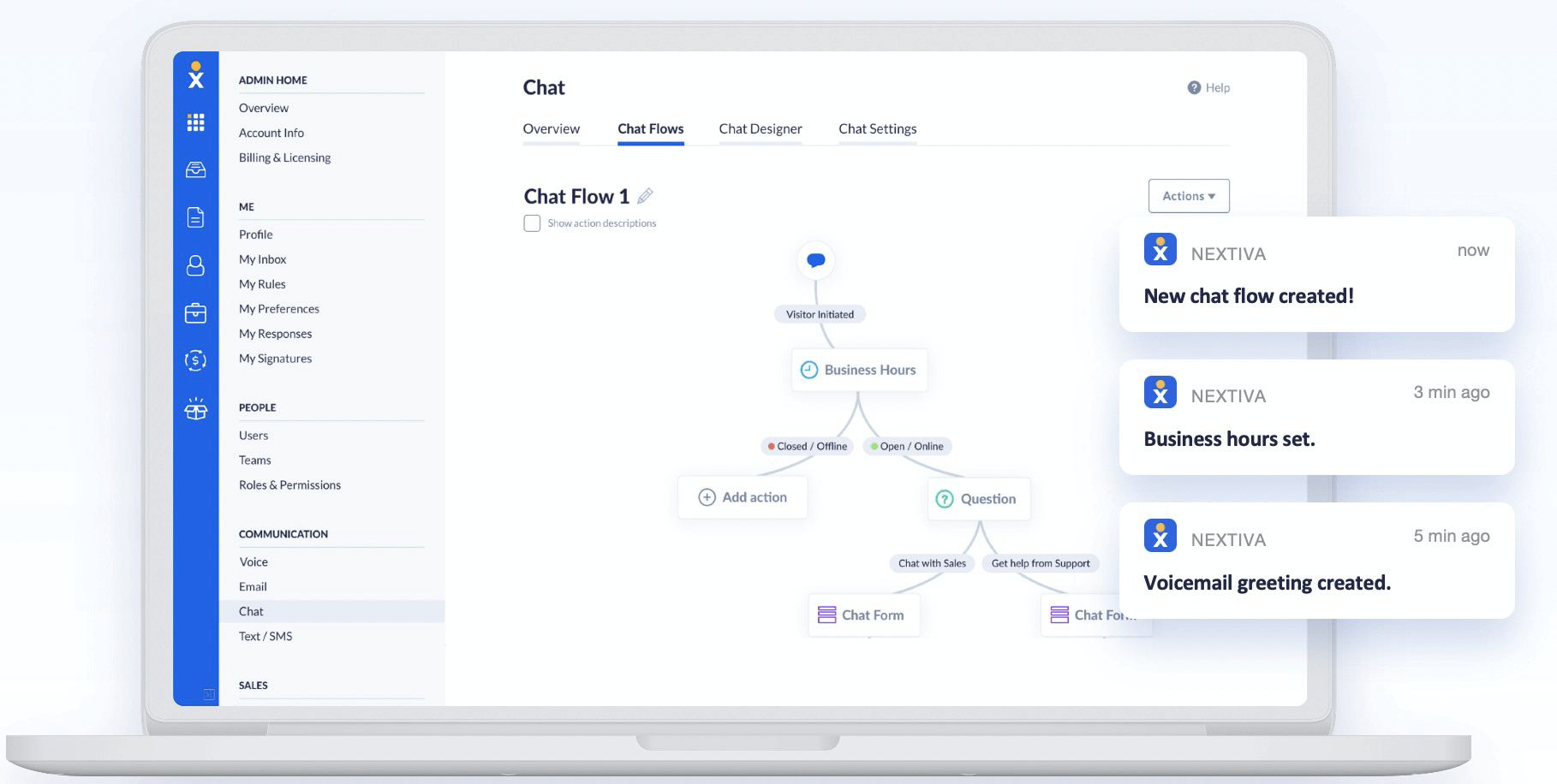
Deeper Dive Into How Call Routing Works
Routing incoming phone calls happens based on three stages:
- Call Qualifying
- Call Queueing
- Call Distribution
Step 1: Call qualifying
Callers enter the business phone system through the VoIP provider, accepting the call from the telephone network or other call carriers.
In the call qualification stage, the phone system identifies the person calling with their caller ID, CNAM database, and possibly your CRM.
Depending on the business number they dialed and the auto attendant selections made, additional details about the call can be determined.

Here’s a simple example. In the qualification stage, all we know is that 602-555-1212 dialed your toll-free number, and their name is “John Doe.” Using your CRM, your call routing system can see that “John” has an outstanding invoice and needs to reach the billing department.
Step 2: Call queuing
Now that the caller has been identified, we need to direct them to the proper queue. A “queue,” in this sense, is a “department” for handling calls of a certain type. Sales, billing, and customer support are types of call queues.
Depending on your business needs, you might have a multi-level auto attendant or simply a couple of different destinations for handling incoming calls.
The ACD monitors which agents are available before transferring the call. When the agent’s line is free, it connects the call to the appropriate agent assigned to the call queue.
During this stage, the call is sitting on hold, waiting for the next available agent.
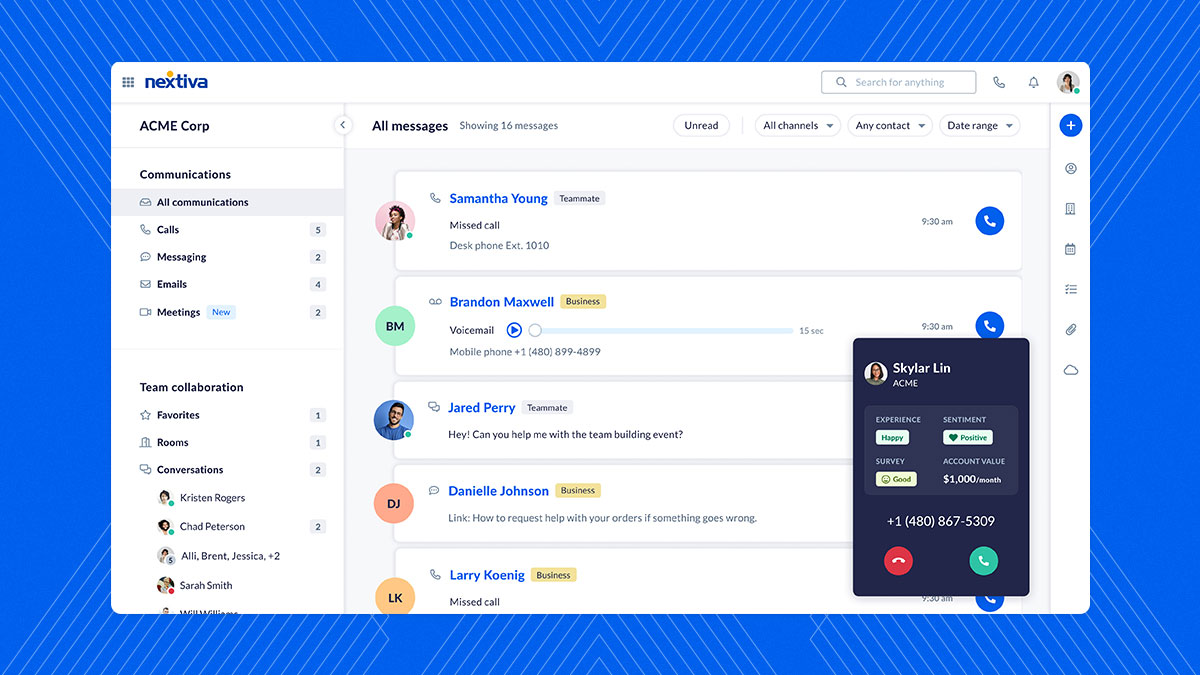
Step 3: Call distribution
If other call routing rules are set up, this is when they’re used to prioritize calls along round-robin, skills-based routing, etc.
Depending on the caller’s input, such as requesting a queue callback or if the call is abandoned (hung up), it affects which calls are distributed to team members.
Once the agent is ready for the call, your phone system connects them together.
It’s also possible that when agents are unavailable, say after business hours, you might opt to direct them to a voicemail or use call forwarding to direct calls to someone who’s on-call.
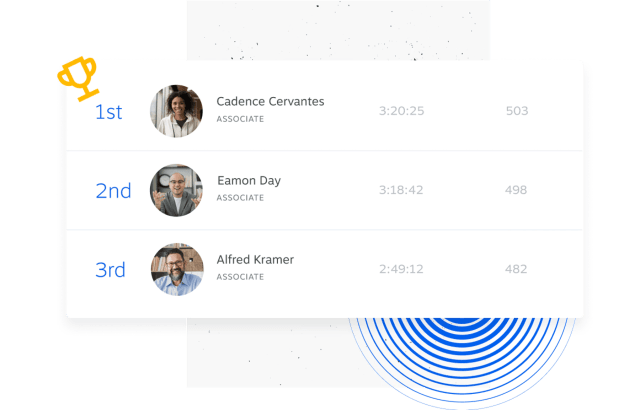
That’s a lot of work just to manage incoming calls! With a robust business phone system, you can deliver a top-notch customer experience and scale your operations.
The good news is that with a modern communications solution like Nextiva, you can adjust these call routing options anytime you want.
FAQs
Call routing is the method of handling incoming calls and directing them to the right live agent based on business needs, customer preferences, and internal workflows. This phone system function is also known as a call flow.
Call distribution, however, relates to one aspect of call routing that prioritizes which agents will receive the next incoming calls and in what order.
Interactive Voice Response systems, or IVR systems, are VoIP-based call routing systems that use a set of pre-recorded greetings and menu options. Once the user’s call gets connected to the system, they’re greeted and presented with these options that lead to other options in a logical flow.
Small businesses can easily direct incoming calls to the right person on their team with an auto attendant that uses a touch-tone-based response to direct the call appropriately.
It only takes a few minutes to set up with Nextiva. As the caller navigates through the menu, the phone system provides them with an automated solution or connects with the agent who will be able to provide them with the best solution for their request. An IVR-based system does not need another ACD but often works in tandem with one.
ACD is short for Automated Call Distribution. These are automated call routing solutions, usually bundled in call center software, that aim to connect an incoming call to the best possible agent within the shortest time


